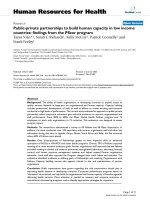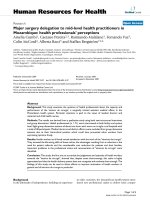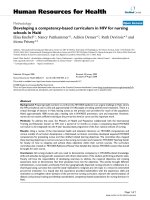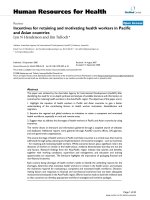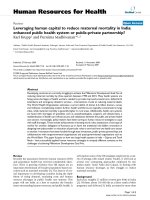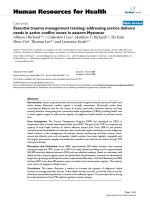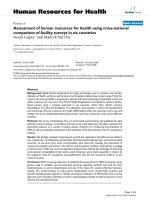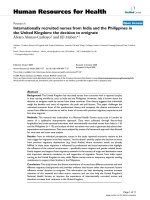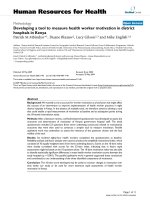báo cáo sinh học:" Developing a tool to measure health worker motivation in district hospitals in Kenya" pot
Bạn đang xem bản rút gọn của tài liệu. Xem và tải ngay bản đầy đủ của tài liệu tại đây (236.81 KB, 11 trang )
BioMed Central
Page 1 of 11
(page number not for citation purposes)
Human Resources for Health
Open Access
Methodology
Developing a tool to measure health worker motivation in district
hospitals in Kenya
Patrick M Mbindyo*
1
, Duane Blaauw
2
, Lucy Gilson
2,3
and Mike English
1,4
Address:
1
Kenya Medical Research Institute Centre for Geographic Medical Research Coast-Wellcome Trust Collaborative Programme, Nairobi,
Kenya,
2
Centre for Health Policy, School of Public Health, University of the Witwatersrand, Johannesburg, South Africa,
3
Health Policy Unit,
London School of Hygiene and Tropical Medicine, London, UK and
4
Department of Paediatrics, University of Oxford, John Radcliffe Hospital,
Oxford, UK
Email: Patrick M Mbindyo* - ; Duane Blaauw - ;
Lucy Gilson - ; Mike English -
* Corresponding author
Abstract
Background: We wanted to try to account for worker motivation as a key factor that might affect
the success of an intervention to improve implementation of health worker practices in eight
district hospitals in Kenya. In the absence of available tools, we therefore aimed to develop a tool
that could enable a rapid measurement of motivation at baseline and at subsequent points during
the 18-month intervention study.
Methods: After a literature review, a self-administered questionnaire was developed to assess the
outcomes and determinants of motivation of Kenyan government hospital staff. The initial
questionnaire included 23 questions (from seven underlying constructs) related to motivational
outcomes that were then used to construct a simpler tool to measure motivation. Parallel
qualitative work was undertaken to assess the relevance of the questions chosen and the face
validity of the tool.
Results: Six hundred eighty-four health workers completed the questionnaires at baseline.
Reliability analysis and factor analysis were used to produce the simplified motivational index, which
consisted of 10 equally-weighted items from three underlying factors. Scores on the 10-item index
were closely correlated with scores for the 23-item index, indicating that in future rapid
assessments might be based on the 10 questions alone. The 10-item motivation index was also able
to identify statistically significant differences in mean health worker motivation scores between the
study hospitals (p < 0.001). The parallel qualitative work in general supported these conclusions
and contributed to our understanding of the three identified components of motivation.
Conclusion: The 10-item score developed may be useful to monitor changes in motivation over
time within our study or be used for more extensive rapid assessments of health worker
motivation in Kenya.
Published: 20 May 2009
Human Resources for Health 2009, 7:40 doi:10.1186/1478-4491-7-40
Received: 8 July 2008
Accepted: 20 May 2009
This article is available from: />© 2009 Mbindyo et al; licensee BioMed Central Ltd.
This is an Open Access article distributed under the terms of the Creative Commons Attribution License ( />),
which permits unrestricted use, distribution, and reproduction in any medium, provided the original work is properly cited.
Human Resources for Health 2009, 7:40 />Page 2 of 11
(page number not for citation purposes)
Background
There has been an upsurge of interest in human resources
required to deliver health care in low-income settings as
part of the drive to achieve the Millennium Development
Goals. Much of the attention, including in Kenya, has
focused on the inadequate numbers of health care work-
ers and their inequitable distribution [1-3]. However, it is
increasingly appreciated that attention must also be paid
to health worker performance [4-8]. Many factors – rang-
ing from available physical infrastructure to an individ-
ual's highly personal values – influence the performance
of health professionals [6]. Many of these factors influ-
ence performance through the health worker's motiva-
tion, where motivation is defined as an individual's
degree of willingness to exert and maintain an effort
towards attaining organizational goals [9].
Although it is likely that motivation influences perform-
ance directly and mediates or modifies the effect of inter-
ventions aimed at changing performance [6], there are few
studies on its influence on practice change in health work-
ers in low-income settings [6,10]. The existing studies
have focused predominantly on determinants of motiva-
tion, with less literature focusing on conceptualizing and
measuring worker motivation [11-14]. One way of meas-
uring motivation is delineated by Franco et al.'s model [9]
(based on Kanfer 1999) [11], which divides determinants
of motivation into "will do" (i.e. adoption of organiza-
tional goals) and "can do" components (i.e. mobilization
of personal resources to attain joint goals) that operate at
individual, organizational and societal levels [9,11]. Moti-
vational outcomes are viewed to be the net results of the
interaction between the "can do" and "will do" compo-
nents of motivation [9,11] and are the main focus of this
study. This approach views worker motivation to be the
result of the interaction of individuals and organizations,
rather than an attribute of either alone [11].
To measure motivation, one can either use subjective
(asking workers their perceptions of motivation and what
influences it) or objective measures (directly observing
issues such as timeliness, or checking attendance records)
[11,14]. While objective measures of assessment are
thought to be better than subjective ones, indicators such
as absenteeism would be very difficult to apply in our cir-
cumstances where, for example, records are poor or non-
existent. On the other hand, directly asking workers
whether or not they are motivated risks introducing
response bias (i.e. respondents answering questions in the
way they think the questioner wants them to be answered,
rather than according to their true beliefs).
With these considerations in mind, we assessed motiva-
tion by examining underlying issues grouped around rel-
evant outcome constructs such as job satisfaction, general
motivation, burnout, work quality, absenteeism or turno-
ver [11,14] that collectively reveal levels of motivation.
Studies tackling this issue in developing country settings
have predominantly used qualitative methods, as shown
by work done in Ethiopia [15], Tanzania [12] and North
Viet Nam [16], with a mixed-methods approach being
used in Mali [13].
We therefore explored the possibility of using a self-
administered questionnaire to measure motivation
among Kenyan health workers in eight hospitals. These
hospitals are taking part in a study evaluating the imple-
mentation of guidelines intended to improve paediatric
care [17,18]. A suitable measure of motivation would
allow us to examine motivation as a contextual influence
on the ability of the intervention to improve health
worker practice in district hospitals in Kenya.
Furthermore, a tool that could be rapidly administered to
large numbers of staff and in large numbers of facilities
might allow motivational scores to be used to explore, at
least in part, the association of motivation with health sys-
tem performance. While such large-scale studies would
provide the ultimate test of the validity of a scoring tool,
the present work focuses on the process of tool develop-
ment.
Methods
Overview of the study
This work was part of a set of baseline surveys undertaken
for a larger intervention study being conducted in selected
Kenyan district hospitals. The main study seeks to investi-
gate the degree to which the quality of paediatric inpatient
care in these sites can be improved and is described in
detail elsewhere [17,18]. The intervention has been devel-
oped with the Ministry of Health (MoH) and is being
delivered over 1.5 years to four intervention hospitals and
in a much more limited fashion to four control hospitals
(i.e. five-day intensive training with supervision as well as
written and verbal feedback, versus 1.5 days of lectures
and written feedback but without supervision) [17,18].
The clinician's uptake of and adherence to practice guide-
lines is being assessed within each hospital; those findings
will be reported in due course.
Our aim here was to develop a tool (i.e. a simple motiva-
tional index) to measure motivation that was as parsimo-
nious as possible [11] and that could be used to describe
motivation in more rapid, repeated assessments in the
future. We reasoned that a quantitative or semiquantita-
tive tool for measuring motivation, particularly one that
can be easily administered, would allow us to explore
both the influence of baseline motivation in a hospital on
the response to the intervention and the interaction
between motivation and delivery of the intervention over
Human Resources for Health 2009, 7:40 />Page 3 of 11
(page number not for citation purposes)
time. Qualitative work was undertaken as part of the
larger study [17,18] to explore in-depth issues around
motivation that would affect the implementation of the
practice change intervention. In this paper, qualitative
work was undertaken to assess the relevance of an initial
longer set of questions and to explore the face validity of
the tool [19].
Tool development
The starting point for potential constructs and questions
to be included in the self-administered questionnaire
(SAQ) was a questionnaire prepared for South African
nurses [20], in turn based on earlier work in Georgia and
Jordan [11,21]. Additionally, literature was reviewed on
studies of motivation of health workers, taking particular
note of those we considered most relevant to the Kenyan
situation [9,11,13,14,20,22-24]. From these sources, and
from a review of studies that used motivation theory in
health [10], we identified constructs we felt could be cate-
gorized as likely outcomes of motivation.
We therefore began by including a broad range of con-
structs considered potentially important, while aiming to
include at least three questions per construct. This resulted
initially in 17 potential constructs divided into two broad
categories representing determinants (10 constructs) and
outcomes (seven constructs) of motivation. As a result,
the initial, pilot SAQ had 71 questions answered on a five-
point Likert scale ranging from "strongly " to "strongly
disagree" The questionnaire also included a "Don't know"
response for each question. Questions were randomly
assorted, with about 40% worded negatively to avoid
response-set bias.
Pilot-testing
The SAQ was pilot-tested in two non-study public hospi-
tals in Kenya to test for clarity of questions and to gain
preliminary insight into the SAQ's construct validity.
Fifty-five pilot questionnaires were received and analysed,
first by checking the direction, magnitude and variability
of the responses. Second, correlation of items within a
construct were tested with Cronbach's alpha, evaluating
the degree to which responses within sets of questions
supported their theoretical grouping.
Questions not performing as expected were reworded for
clarity. In some, this meant reversing the negative wording
that seemed to be responsible for the question's poor per-
formance, because respondents misunderstood the
intended meaning. This process was complemented by
concurrent qualitative work that helped to identify poten-
tially sensitive questions [25].
Based on the pilot results, a SAQ with 17 constructs and
66 questions was finally developed. The focus of the
present report is restricted to data from the seven con-
structs and 23 questions relating to motivational out-
comes that were used to develop a score of motivation
(Table 1).
Sampling and data collection
On the basis of previous survey experience [26], whole-
population sampling was not considered feasible in the
study setting of rural Kenyan hospitals. A sample of 30%
(i.e. 90 staff members from each hospital) and a total
sample size of 720 was considered statistically adequate
for these analyses. All baseline data were collected by
identically trained survey teams on-site (two weeks per
site) who distributed and collected SAQs to staff members
expected on duty for more than two days during the sur-
vey period. Staff members working in paediatric areas or
other areas but with regular contact with sick children in
their day-to-day work were preferentially targeted for SAQ
distribution, because the main intervention was aimed at
improving paediatric care.
All qualitative data were collected by the lead author dur-
ing one-week visits to each hospital made after the depar-
ture of the main survey teams [27,28]. These visits were
conducted from late August to September 2006 prior to
any intervention. A purposive sampling approach was
used to select participants to be interviewed. The hospital
CEO, administrator, matron and ward in-charges and cli-
nicians (doctors and clinical officers) were chosen as key
informants, as they are few in number but have a wide
knowledge of hospital operations due to their job func-
tions. As such, an effort was made to interview all present
during the one-week visit. Focus group discussions
(FGDs) were conducted among nurses (especially in
maternity and child health sections), as they form over
50% of the clinical staff in the hospitals. Focus group dis-
cussions took place mainly in the late afternoons, when
workloads were considerably reduced.
Data analysis
Data were double-entered by means of a purpose-
designed Microsoft Access 2003 interface. The principal
investigator carried out verification, including checking of
missing data [29]. After this, quantitative data were ana-
lysed with STATA 9.2. Likert-scale responses were entered
as a score of 1 to 5. A score of 5 represented the statement
"strongly agree" for positively-worded questions, while
negative questions were coded in the opposite direction,
so that a score of 5 represented "strongly disagree".
Responses to individual questions were examined by
means of frequency distributions, mean and median
scores and examining whether the direction of response
was as anticipated and consistent with responses within
and across constructs – especially for negatively-worded
Human Resources for Health 2009, 7:40 />Page 4 of 11
(page number not for citation purposes)
questions. The relationships between responses to ques-
tions forming a construct were examined using Pearson's
and rank correlation (coefficients above 0.5 were deemed
to be good) and as a set using Cronbach's alpha.
Factor analysis was used to identify groups of interrelated
variables. Underlying constructs, also known as latent fac-
tors, were deduced from the correlations between the
measured variables of the questionnaire and provided a
basis for data reduction and the development of a new
simplified index.
Qualitative data were transcribed and imported into
NVIVO7, where identification of themes followed the
conventional coding process [30]. The results were com-
bined and subsequently collated into relevant, larger the-
matic categories to improve explanatory ability.
Ethical issues
Ethical clearance for the broader study was obtained from
Kenya's National Ethics Review Committee, and permis-
sion was sought from the heads of each hospital. Oral
assent was sought for administering a SAQ; written con-
sent was sought for interviews and FGDs from the study
participants.
Results
Quantitative data
In total, 720 SAQs were distributed and 684 (95.0%) were
returned. Of the 684 SAQ's returned, one had almost no
recorded responses and another 15 (evenly distributed
across the eight sites) had > 20% missing responses; all of
these were subsequently dropped from further analysis. In
the 668 remaining SAQs, out of the 44 088 total possible
responses (668 × 66), 89 were missing (0.2%) and 621
were "Don't know" responses (1.4%). Factor analysis
requires complete data, and thus these analyses could
have been restricted to a set of 427 perfectly complete
SAQs. As this would have resulted in a large number of
valid responses' being dropped, we imputed for each
"Don't know" response a neutral response (score 3) to cre-
ate a complete dataset of 634 SAQs for factor analysis (34
Table 1: Motivational outcome constructs and questions
Construct Questions Mean score
(1–5)
General motivation These days, I feel motivated to work as hard as I can 2.77
I only do this job so that I get paid at the end of the month 4.01*
I do this job as it provides long term security for me 3.54*
Burnout I feel emotionally drained at the end of every day 2.79*
Sometimes when I get up in the morning, I dread having to face another day at work 3.39*
Job satisfaction Overall, I am very satisfied with my job 3.42
I am not satisfied with my colleagues in my ward 3.83*
I am satisfied with my supervisor 3.62
Intrinsic job satisfaction I am satisfied with the opportunity to use my abilities in my job 3.79
I am satisfied that I accomplish something worthwhile in this job 4.17
I do not think that my work in the hospital is valuable these days 4.05*
Organizational commitment I am proud to be working for this hospital 3.93
I find that my values and this hospital's values are very similar 2.95
I am glad that I work for this facility rather than other facilities in the country 3.23
I feel very little commitment to this hospital 3.89*
This hospital really inspires me to do my very best on the job 2.97
Conscientiousness I cannot be relied on by my colleagues at work 4.42*
I always complete my tasks efficiently and correctly 3.98
I am a hard worker 4.50
I do things that need doing without being asked or told 4.28
Timeliness and attendance I am punctual about coming to work 4.27
I am often absent from work 4.50*
It is not a problem if I sometimes come late to work 4.16*
* The scale for negatively worded questions was 1(strongly agree) to 5 (strongly disagree). Thus a high score shows disagreement with a negative
statement and is therefore suggestive of higher motivation.
Human Resources for Health 2009, 7:40 />Page 5 of 11
(page number not for citation purposes)
SAQs remained excluded from factor analysis because of
genuinely missing responses).
We compared the factor analyses of the original dataset
with the one using imputed values. As there were no mate-
rial differences between the results and because imputing
missing data made maximum use of the actual responses
provided, we report here only the results from the analy-
ses incorporating imputed data.
There were differences in the profiles of respondents
between hospitals, with considerable variation in the pro-
portion who were clinicians, the proportion who worked
in paediatric areas (as defined above) and the proportion
who were female (Table 2). These differences between
hospitals reflect both their difference in total and depart-
mental size – smaller hospitals have fewer clinicians – and
perhaps the sampling approach (the data collection proc-
ess focused on staff members primarily working in paedi-
atric areas, where the intervention was to be
implemented). Overall there were more female (58.9%)
respondents than male (41.1%), which concurs with the
findings of the 2004 MoH Human Resource Mapping
exercise, which found more female workers (52.7%) than
male (47.3%) in Kenya's health workforce [5]. In terms of
workplace, the main non-paediatric areas represented
were adult inpatient services (17.6%) and laboratory and
radiology departments (6.0%).
The mean score for each of the original 23 questions is
shown in Table 1. The means have been calculated with
the scoring of negative questions reversed (as described
above) so that higher means indicate higher motivational
outcomes whatever the wording of the original question.
The highest mean scores were for questions 19 and 22,
indicating that the majority of respondents strongly
agreed that they were hard workers and disagreed that
they were often absent from work. Nevertheless, the low-
est mean score was for question 1, which suggests that
many participants would describe themselves as demoti-
vated.
Analysis of motivational outcomes
We used both inter-item correlation and factor analysis to
evaluate patterns in the responses of respondents.
Through correlation, we examined how questions per-
formed within and between constructs. All 23 questions
taken together as a single index of motivation had a Cron-
bach's alpha of 0.75. Individual constructs performed less
well, with Cronbach's alphas ranging from 0.36 to 0.64
demonstrating, in part, the relationship between
increased number of questions per construct and higher
Cronbach's alpha scores.
Factor analysis, on the other hand, showed that three latent
factors explained the majority of the variance in the data.
These results (not shown) suggested that the motivational
outcome questions in the SAQ related to three main under-
lying themes, rather than the seven originally proposed
constructs. Questions related to the organizational com-
mitment loaded onto the first latent construct (39.5% of
variance). The second latent construct (28.7% of variance)
gathered together questions around conscientiousness,
timeliness and attendance, while questions associated with
general motivation, job satisfaction and burnout loaded
onto the third latent construct (23.3% of variance).
A simplified index of motivation
Although we could have used a motivation score with all
23 items, we aimed to be as parsimonious as possible and
produce a more simplified index to facilitate subsequent
data collection. To reduce the number of questions
needed, we initially identified items with the highest fac-
tor loadings on the three main latent factors and then
adhered to the following principles: balancing the
number of questions from each construct, dropping those
that correlated least well, and examining inter-item corre-
lation and Cronbach's alpha to include questions that
performed well within their constructs and for the overall
index. This resulted in selection of 10 primary questions
whose factor analysis results are shown in Table 3. The 10
questions grouped into the same three underlying factors,
but factors 2 and 3 were now reversed. As can be seen in
Table 2: Respondent characteristics for the eight study hospitals
Hospitals
Respondent characteristics H1H2H3H4H5H6H7H8 Total
(%)
X
2
P value
Gender (female %) 59.8 72.4 49.3 69.1 51.8 47.9 61.0 58.4 58.9 17.6 0.014
Paediatrics (%) 39.569.645.050.032.560.348.854.8 49.6 30.4 < 0.001
Clinicians (%) 77.5 83.8 73.0 70.9 67.9 52.6 72.4 73.1 71.6 21.6 0.003
Human Resources for Health 2009, 7:40 />Page 6 of 11
(page number not for citation purposes)
Table 3, the weightings for each question were fairly sim-
ilar. Therefore, to simplify subsequent use of the index, we
proposed using an equally-weighted index using these 10
questions. Using the original scoring of 1 to 5 for each
question meant that the index would have a potential
range from 10 to 50, with a midpoint of 30.
We confirmed that the simplified 10-item index was com-
parable to the original index by calculating the Pearson's
correlation coefficients of individual's scores (Table 4).
We found a strong correlation of 0.9608 (p < 0.0001)
between our shorter, equally-weighted 10-item score and
the score for all 23 questions. Table 4 also confirms that
the score using equally weighted questions is very similar
(r = 0.9821) to the more accurate score derived from fac-
tor analysis.
Using the score
Using the simple, equally weighted, 10-item index, we cal-
culated the mean motivational score for each study hospi-
tal (Table 4). The mean motivational scores for the eight
hospitals ranged from 35.9 (H6) to 39.3 (H2), indicating
generally positive motivation levels, since the means were
all above 30. Overall, the differences in mean motivation
scores between hospitals were statistically significant
(ANOVA, p < 0.001), but multiple comparisons testing
revealed that the differences were primarily between the
three lowest-scoring hospitals (H6, H1 and H7) in com-
parison to H2, the highest scoring hospital (Bonferroni
test, p < 0.05).
Clearly the score based on 10 items represents a summa-
rization of item scores from the three latent factor group-
Table 3: Factor analysis of the 10-item motivation index (rotated factor loadings and unique variances)
Variable Factor 1: Organizational commitment Factor 2: Job satisfaction Factor 3: Conscientiousness
No motivation 0.4478
Very satisfied with job 0.5928
Satisfied with opportunity to use my abilities in my job 0.5348
Job makes me feel good about myself 0.4199
Proud to be working for this hospital 0.5420
Glad to work for this facility than others in the country 0.5701
Hospital inspires me to do my very best on the job 0.4837
I always complete my tasks efficiently and effectively 0.5224
I am a hard worker 0.5322
I am punctual about coming to work 0.4812
Blanks represent |loading| < 0.4
Table 4: Correlation between different motivation scores
23-Item Score
(Factor loadings)
10-Item Score
(Factor loadings)
10-Item Score
(Equally weighted)
23-Item Score
(Factor loadings)
1.0000
10-Item Score
(Factor loadings)
0.9798
(p < 0.001)
1.0000
10-Item Score
(Equally weighted)
0.9608
(p < 0.001)
0.9821
(p < 0.001)
1.0000
Human Resources for Health 2009, 7:40 />Page 7 of 11
(page number not for citation purposes)
ings. In Table 5 we also present the mean score per item
for each of the three latent factor groupings. In general,
the high-scoring hospitals overall appear to have higher
scores in comparison with other hospitals for each latent
factor, although there is some variability in rankings when
comparing the overall score with the factor-specific scores.
Interestingly, the factor-specific mean scores show consist-
ency within a factor grouping, with hospitals having rela-
tively similar absolute mean scores and relatively small
standard deviations in all cases. However, there is variabil-
ity in the absolute values of the means between factor
groupings. Thus latent factor 2 (job satisfaction) has con-
sistently low scores in each hospital, followed by factor 1
(organizational commitment), while factor 3 (conscien-
tiousness) is higher than both. The higher scores for factor
three items might be because questions in factor 3 reflect
on them as individuals (a form of positive response bias),
while the lower job satisfaction and organizational com-
mitment scores perhaps reflect more on the "system".
We used multiple regression to explore whether or not the
differences in characteristics of the hospital respondents
at baseline (see Table 2) explained the difference in moti-
vation scores between hospitals. The results of this regres-
sion are shown in Table 6. Certain differences between
hospitals persisted in multivariate analysis – H2 was sig-
nificantly higher, and H1 had significantly lower motiva-
tion scores than average. Female health workers, working
in paediatrics and being a clinical officer (CO) did not sig-
nificantly affect motivation, but medical officers (MOs)
had statistically lower scores, and non-clinical workers
were more motivated than average. Although the overall
model was statistically significant, it had very limited
explanatory power (R
2
= 0.056). This is in contrast to a
regression model that included the motivational determi-
nants from the original questionnaire (results not shown)
that had an R
2
of 0.551.
Qualitative results
Our use of qualitative approaches was two-fold: to
improve SAQ development and to help us understand the
SAQ results. With regard to SAQ development, qualitative
work improved the tool, as explained previously in this
paper, showing unclear questions that needed rephrasing.
In terms of explanatory ability, our understanding of the
data captured by the SAQ was supported or enhanced by
qualitative data. These findings will be discussed further
in the next section.
Discussion
The motivation score
Based on existing conceptual and empirical work, we
developed an SAQ to assess motivation in hospital-based
Kenyan health workers. Additionally, a comparison of the
quantitative and qualitative results was made to help
understand the motivation score. Very high response rates
were achieved by research staff as a result of combining
SAQ administration with other hospital survey tools
[17,18]. By means of factor analysis we identified 10 ques-
tions, representing three latent factors, that appeared suit-
able for use as a rapid tool for quantitative assessments of
motivation.
Qualitative data and reflection on observations made by
the PI in this study during fieldwork suggest that the sim-
plified index appropriately indicates variable levels of
motivation between hospitals, showing that the score
could be an important component of motivation analysis.
Table 5: Mean summary 10-item motivation score (minimum 10, maximum 50), from highest to lowest, and mean item scores for
each latent factor by hospital
Hospital Mean 10-Item Motivation Score Standard Deviation Mean Latent Factor 1 Mean Latent Factor 2 Mean Latent Factor 3
H2 39.31 4.83 3.80 3.67 4.37
H3 37.93 5.33 3.74 3.47 4.20
H4 37.09 5.29 3.49 3.34 4.35
H8 36.62 4.87 3.57 3.39 4.05
H5 36.46 5.43 3.49 3.18 4.27
H7 36.29 5.63 3.33 3.39 4.27
H1 36.04 6.27 3.55 3.02 4.25
H6 35.91 5.88 3.40 3.20 4.23
Average 36.94 5.54 3.55 3.33 4.25
Human Resources for Health 2009, 7:40 />Page 8 of 11
(page number not for citation purposes)
For example, the qualitative analysis suggested that man-
agement in the hospital with the highest mean motiva-
tional score (H2) was considerably better than the
average, and supported the conclusion that motivation
was highest in that hospital. However, it should be
remembered that neither hospital staff nor hospitals were
randomly selected, and thus hospital mean scores should
be interpreted cautiously. This does not, in our opinion,
detract from the usefulness of the index or the finding that
the index was able to differentiate study hospitals accord-
ing to their workers' reported motivational levels.
Further, while reflecting variability between sites, care
should perhaps be taken not to over-interpret the absolute
values of the index score. While the score appears to sug-
gest that on average people were slightly more positive
than negative, with a mean of 36.9 out of a possible 50
points, these data still suggest the need for improvements
in motivation of health workers, a view strongly rein-
forced by the qualitative work (in preparation).
When scores within individual item groupings resulting
from factor analysis are examined, some consistency in
hospital ranking is observed, although there is a sugges-
tion that scores are quantitatively lower (satisfaction) for
some factor groupings than others (conscientiousness),
although this may be explained by response biases. Addi-
tionally, the score is unable to show nuances such as the
role of leadership in improving worker motivation or the
importance of clear communication between hospital
management and staff, which were clearly highlighted in
the qualitative work. This being so, there is need for com-
plementary qualitative approaches that improve the
researcher's ability to explain such findings [19].
Qualitative and quantitative results
With regard to motivational outcomes, the first latent fac-
tor grouped together questions around organizational
commitment with relatively high mean scores (Tables 1
and 5). Qualitative data reveal that all health workers were
attracted to health care work by some aspect of public
service or the altruistic nature of health care provision,
suggesting a strong sense of attachment subsequently
reinforced by professional training. However, an inability
to do their work due to constraints such as high work-
loads, old buildings and lack of drugs and non-medical
supplies caused dissatisfaction with health care work. This
led to outcomes such as: " staff experience [ing] burnout
resulting in poor attitudes to patients and work." [Matron,
H1]. Other outcomes include shirking duties, moonlight-
ing, laxity at work or efforts to change jobs, which echo
findings in Ethiopia [15] and Malawi [31]. As such, the
SAQ responses in the first latent factor appear related
more to workers' commitment to the ideals of health
work as a profession and less perhaps to actual, individual
behaviours such as acceptance of organizational goals,
working practices or intention to remain in the organiza-
tion [32].
However, organizational commitment could be positively
modified by efforts of senior management, as shown by
qualitative data. In one site (H3) where a senior adminis-
trator was actively involved in running the hospital, moti-
vation was reportedly high despite the site's having small
buildings and shortages of medical supplies and equip-
ment. Where this did not happen, a worker felt that: "a lit-
tle effort by the med sup [medical superintendent] to
have, say, an annual process of recognising staff say,
Nurse, CO, Doctor etc would really help staff to realise
that the management was watching what they do and
would reward good work" [Senior Clinical Officer, H4].
Thus, the perception that some senior management offic-
ers did not appreciate or recognize their staff [4,33,34]
Table 6: Multiple regression model of motivation score
Variable Coefficient SE p Value
Constant 36.847 0.450 p < 0.000
Hospitals H1 -1.475 0.623 0.018
H2 2.580 0.604 0.000
H3 0.661 0.580 0.255
H4 0.101 0.620 0.870
H5 -0.455 0.578 0.432
H6 -1.086 0.579 0.061
H7 -0.487 0.584 0.405
Gender Male - - -
Female -0.250 0.549 0.649
Paediatric staff No - - -
Yes -0.560 0.483 0.247
Staff category CO 0.240 0.508 0.637
MO -1.948 0.784 0.013
Non-clinical 1.090 0.455 0.017
Overall model: p = 0.0008, R
2
= 0.056
Dummy coding used for Gender and Paediatric variables so that
coefficient is in comparison to reference group. Effect coding used for
Hospital and Staff category variable so that coefficient compares
group to overall mean.
Human Resources for Health 2009, 7:40 />Page 9 of 11
(page number not for citation purposes)
might have the effect of lowering a person's level of con-
scientiousness, resulting in behaviours such as not turning
up to work.
As to the second factor, SAQ data suggest relatively high
levels of self-reported conscientiousness, timeliness and
attendance, which should be reflected by high levels of
productivity in the hospitals (see Table 1). However,
observations and interviews in the same sites show a dif-
ferent picture: "They [hospital staff] have started clocking
in as a result of the laxity, though, even if they come on
time, it is not known if they are working well or not" [Act-
ing Hospital Matron, H4]. This dichotomy is not surprising,
since the SAQ shows the health workers' positive subjec-
tive assessments of their motivation, with which their
supervisors do not agree. This clearly shows the value of
using both subjective and objective measures of motiva-
tion for purposes of triangulation, as well as validating the
results acquired.
Qualitative data also suggested that workers did not differ-
entiate between general motivation and burnout issues as
separate influences over their motivation, which is con-
sistent with the grouping of the two constructs into the
third latent factor by factor analysis. Interestingly, SAQ
responses with reference to the third latent factor gener-
ally revealed low mean scores across all eight sites (Table
1), perhaps because high workloads, shortages of quali-
fied staff and lack of equipment and medical supplies are
commonly encountered.
Limitations of our study
Methodologically, the exploration of a multidimensional
theoretical construct (such as motivation) ideally requires
a substantial number of questions yielding a high Cron-
bach's alpha score for a question set. Since we did not
have prior experience of testing motivation in the Kenyan
context and because we wished to produce a question-
naire of manageable length, we chose to have a relatively
broad range of constructs with relatively few questions per
construct. This is because of the general feeling that very
long questionnaires are less well completed which means
that there are trade-offs in tool design in terms of length,
number of constructs and number of questions per con-
struct.
Additionally, respondents' perceptions of what consti-
tutes an acceptable answer, how their answers reflect on
them, or what they think the investigator wishes to hear
might have influenced the way they answered our ques-
tions [25]. To overcome response-set bias, we worded half
the questions positively and the other half negatively. We
found, during the pilot phase, that positive questions
seemed to perform better in our context, which may
explain why all questions included in our 10-item score
are positive. This is similar to other findings from lower-
income settings reported by Franco and her colleagues
[21]. Here, the context of implementation of the project
also needs to be considered. The baseline survey was a
year after resumption of duties by health workers who
were affected by a general health workers' strike that took
place in June 2005, which we believe may have influenced
their responses negatively.
Our analysis was also potentially affected by a number of
truly missing responses and inclusion of a "Don't know"
option. This option was included as a result of pilot work
suggesting that some participants did not want to answer
more sensitive questions or sometimes did not know how
to answer the question. This possibly reflects the difficulty
in adapting questions developed in other settings [11].
However, results indicate that the "Don't know" response
was made in only 1.4% of possible occasions. Thus,
although the literature shows that the inclusion of the
"Don't know" option may substantially lower the number
of respondents offering their opinions [25], in our case it
would seem to have made little difference to our overall
interpretation. Conversely, the limited use of this option
would also indicate that a "Don't know" response could
be omitted in future questionnaires.
This study could have been improved by collecting SAQ
data from a simple random sample of each hospital's
health care staff or including only staff working in paedi-
atric areas, at whom the intervention is primarily
intended. However, while a different study sample might
affect the magnitude of the hospital scores, it seems
unlikely that it would result in selection of a very different
10-item index.
We are also aware that there are true differences in staffing
patterns between hospitals that would be reflected in a
hospital summary score. One example is the proportion
of interns (i.e. pre-registration clinicians completing one
year of experience prior to registration), which does differ
between hospitals, but that we were unable to analyse sep-
arately because there were too many missing data for that
question. For these reasons, interpreting the summary
scores as typical of Kenyan hospital settings should be
approached cautiously. However, the working areas we
focused on represent a substantial proportion of the hos-
pital (antenatal and maternal and child health clinic; gen-
eral outpatient/emergency area, maternity ward and
paediatric wards) and we achieved a very high response
rate (95%). Additionally, the quantitative findings were in
general supported by the parallel qualitative work and the
opinions of the returning survey staff that were all consist-
ent in identifying the least and most motivated hospitals.
More generally, our results reflect responses from hospi-
tal-based health workers predominantly providing serv-
ices in areas where paediatric and paediatric-related care is
Human Resources for Health 2009, 7:40 />Page 10 of 11
(page number not for citation purposes)
required, from eight Kenyan district hospitals. From this
starting point, we have been able to develop a potentially
rapid motivation measurement tool aimed at exploring
motivation as a contextual influence on uptake of new
practices. Qualitative work suggests that altruistic motives
are important to Kenyan health workers, though numer-
ous difficulties facing the provision of health care in the
public sector threaten their organizational commitment
and general motivation. Further, our qualitative findings
are similar to those reported in the literature from other
similar settings [12,15,16].
Conclusion
There are no "gold standard" tools to measure motivation,
so we set out to develop an easily administered, quantita-
tive tool that might allow us to explore the influence of
baseline motivation on the response to a hospital-based
intervention to change health worker practices and, later,
the interaction between motivation and delivery of the
intervention over time. The value of such a score might be
further examined in large-scale studies exploring the asso-
ciation between motivation, measured in this way, and
other attributes of the health system, such as hospital per-
formance.
The focus of the current work was, however, to develop a
rapid tool (eventually of 10 items) that, through factor
analysis, appears to capture motivation quantitatively.
Qualitative data suggest that the questions comprising the
10-item tool approximated issues relevant to staff motiva-
tion in district hospitals. It also emphasizes the need for
an understanding of the context of implementation and
concurrent qualitative work to triangulate results.
The value of this 10 item tool will become apparent only
with repeated field tests, which are ongoing and which
will be reported in due course. While we have restricted
ourselves to interpreting the tool's results at hospital level,
they can be interpreted at the individual level; further
work will examine the link between hypothesized deter-
minants of motivation and the outcomes reported here.
Competing interests
The authors declare that they have no competing interests.
Authors' contributions
All authors contributed to and approved the final manu-
script.
Acknowledgements
This work is published with the permission of the Director, KEMRI. We
would like to thank the Division of Child Health (Ministry of Health) and
the staff of participating district hospitals for their collaboration. This work
is funded through a Wellcome Trust Senior Research Fellowship awarded
to Dr Mike English (#076827). The funders have played no role in the
design of this study.
References
1. WHO: The World Health Report 2006-Working Together
for Health. Geneva: World Health Organization; 2006.
2. Martinez J, Matineau T: Human Resources in the Health Sector:
An International Perspective. London: DFID Health Systems
Resource Centre; 2002.
3. MOHa: The Second National Health Sector Strategic Plan of
Kenya (NHSSP II 2005–2010). Nairobi: Ministry of Health; 2005.
4. Gilson L, Palmer N, Schneider H: Trust and health worker per-
formance: exploring a conceptual framework using South
African evidence. Social Science & Medicine 2005, 61:1418-1429.
5. MOHb: Human Resource Mapping and Verification Exercise.
Nairobi: Ministry of Health; 2005.
6. Rowe AK, de Savigny D, Lanata CF, Victora CG: How can we
achieve and maintain high-quality performance of health
workers in low-resource settings? The Lancet 2005,
366:1026-1035.
7. Hongoro C, McPake B: Editorial: Human resources in health:
putting the right agenda back to the front. Tropical Medicine &
International Health 2003, 8:965-966.
8. Martinez J, Martineau T: Rethinking human resources: An
agenda for the millennium. Health Policy and Planning 1998,
13:345-358.
9. Franco LM, Bennett S, Kanfer R: Health sector reform and public
sector health worker motivation: a conceptual framework.
Social Science & Medicine 2002, 54:1255-1266.
10. Dolea C, Adams O: Motivation of health care workers: review
of theories and empirical evidence. Cahiers de Sociologie et
Démographie Médicale 2005, 45(1):135-161.
11. Kanfer R: Measuring Health Worker Motivation in Develop-
ing Countries. In Major Applied Research 5 Bethesda, MD: Partner-
ships for Health Reform Project, Abt Associates Inc.; 1999.
12. Manongi R, Marchant T, Bygbjerg IC: Improving motivation
among primary health care workers in Tanzania: a health
worker perspective. Human Resources for Health 2006, 4:6.
13. Dieleman M, Toonen J, Toure H, Martineau T: The match between
motivation and performance management of health sector
workers in Mali. Human Resources for Health 2006, 4:2.
14. Bennett S, Franco LM, Kanfer R, Stubblebine P: The Development
of Tools to Measure the Determinants and Consequences of
Health Worker Motivation in Developing Countries. In Major
Applied Research 5 Bethesda, MD: Partnerships for Health Reform
Project, Abt Associates Inc.; 2000.
15. Lindelow M, Serneels P: The performance of health workers in
Ethiopia: Results from qualitative research. Social Science &
Medicine 2006, 62:2225-2235.
16. Dieleman M, Cuong PV, Anh LV, Martineau T: Identifying factors
for job motivation of rural health workers in North Viet
Nam. Human Resources for Health 2003, 1(1):10.
17. English M, Irimu G, Wamae A, Were F, Wasunna A, Fegan G, Peshu
N: Health Systems Research in a Low Income Country – Eas-
ier Said Than Done. Archives of Disease in Childhood 2008,
93:540-544. doi:510.1136/adc.2007.126466.
18. Irimu G, Wamae A, Wasunna A, Were F, Ntoburi S, Opiyo N, Ayieko
P, Peshu N, English M: Developing and introducing evidence
based clinical practice guidelines for serious illness in Kenya.
Arch Dis Child 2008, 93:799-804.
19. Farmer T, Robinson K, Elliott SJ, Eyles J: Developing and Imple-
menting a Triangulation Protocol for Qualitative Health
Research. Qualitative Health Research 2006, 16:377-394.
20. Penn-Kekana L, Blaauw D, Tint KS, Monareng D, Chege J: Nursing
Staff Dynamics and Implications for Maternal Health Provi-
sion in Public Health Facilities in the Context of HIV/AIDS.
In Frontiers in Reproductive Health Johannesburg: Population Council;
2005.
21. Franco L, Bennett S, Kanfer R, Stubblebine P: Determinants and
consequences of health worker motivation in hospitals in
Jordan and Georgia. Social Science & Medicine 2004, 58:343-355.
22. Raviola G, Machoki M, Mwaikambo E, Good MJD: HIV, Disease
Plague, Demoralization, and "Burnout": Resident Experi-
ence of the Medical Profession in Nairobi, Kenya. Culture, Med-
icine and Psychiatry 2002, 26:55-86.
23. Piko BF: Burnout, role conflict, job satisfaction and psychoso-
cial health among Hungarian health care staff: A question-
naire survey. International Journal of Nursing Studies 2006,
43:311-318.
Publish with BioMed Central and every
scientist can read your work free of charge
"BioMed Central will be the most significant development for
disseminating the results of biomedical research in our lifetime."
Sir Paul Nurse, Cancer Research UK
Your research papers will be:
available free of charge to the entire biomedical community
peer reviewed and published immediately upon acceptance
cited in PubMed and archived on PubMed Central
yours — you keep the copyright
Submit your manuscript here:
/>BioMedcentral
Human Resources for Health 2009, 7:40 />Page 11 of 11
(page number not for citation purposes)
24. Ogbimi R, Adebamowo C: Questionnaire survey of working
relationships between nurses and doctors in University
Teaching Hospitals in Southern Nigeria. BMC Nursing 2006,
5:2.
25. Schaeffer NC, Presser S: The Science of Asking Questions.
Annual Review of Sociology 2003, 29:65-88.
26. English M, Esamai F, Were F, Wasunna A, Ogutu B, Peshu N, Snow R:
Assessment of inpatient paediatric care in first referral level
hospitals in 13 districts in Kenya. The Lancet 2004,
363:1948-1963.
27. McLafferty I: Focus group interviews as a data collecting strat-
egy. Journal of Advanced Nursing 2004, 48:187-194.
28. Nunkoosing K: The Problems With Interviews. Qualitative
Health Research 2005, 15:698-706.
29. Broeck J Van den, Cunningham SA, Eeckels R, Herbst K: Data clean-
ing: Detecting, diagnosing, and editing data abnormalities.
PLoS Medicine 2005, 2(10):e267.
30. Hsieh H-F, Shannon SE: Three Approaches to Qualitative Con-
tent Analysis. Qualitative Health Reasearch 2005, 15:1277-1288.
31. Muula A, Panulo B, Maseko F: The financial losses from the
migration of nurses from Malawi. BMC Nursing 2006, 5:9.
32. Kyaddondo D, Whyte SR: Working in a Decentralized System:
A Threat to Health Workers' Respect and Survival in
Uganda. International Journal of Health Planning and Management
2003, 18:329-342.
33. Krogstad U, Hofoss D, Veenstra M, Hjortdahl P: Predictors of job
satisfaction among doctors, nurses and auxiliaries in Norwe-
gian hospitals: relevance for micro unit culture. Human
Resources for Health 2006, 4:3.
34. Connell J, Ferres N: Engendering trust in manager-subordinate
Relationships: Predictors and outcomes. Personnel Review 2003,
32:569-587.
